Words as pictures - Southwest Chinese Naxi manuscripts
In the second half of the 19th century, when European colonial powers were still mapping Asian river valleys, explorers and missionaries accidentally discovered a kind of picture-writing still in use by tribes in southwest China. These tribes would be grouped under one official umbrella: Naxi.
Most writing systems of the world depict words as abstract signs only arbitrarily connected to their pronunciations. But imagine a writing where the written word resembles the very thing it is supposed to indicate: a tree would just be a picture of a tree, a house a picture of a house, etc. What would a book written in these “pictographs” look like? Look no further than the Naxi religious manuscripts from southwest China’s Yunnan province. Each manuscript contains a collection of small dioramas that are comprised of individual pictographic representations, all drawn with simple lines that evoke Egyptian hieroglyphics.
Leiden University Libraries possesses a small but exciting collection of Naxi manuscripts that, to modern eyes, almost look like rudimentary comic books. This blog will introduce some of the special features of the writing and the Leiden University collection.
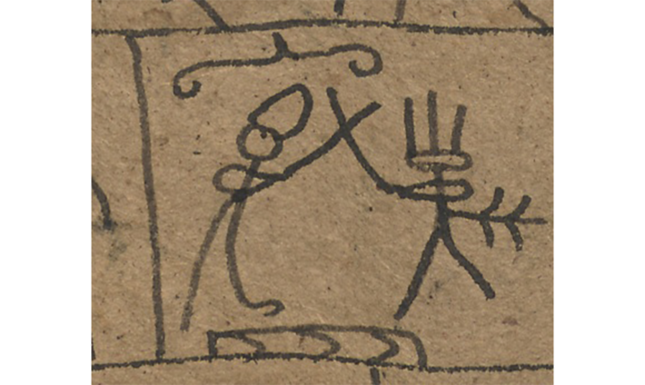

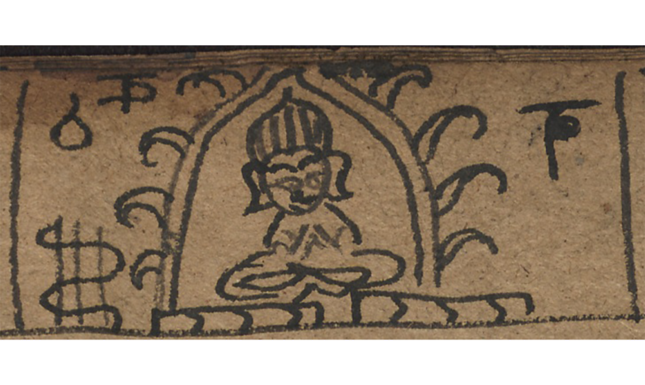

The graphs are at once pictures and words, written words designed to summon into existence – via a performative reading – the sediment of an ancient oral tradition inherited by well-versed Naxi religious practitioners known as the “dongba” when they perform their rituals to appease the gods and spirits or send the deceased on into the afterlife. This writing is known as Naxi dongba script, named after these mediators between the spirit world and the human realm.
Some Chinese scholars suggest that the dongba script originated in the Tang dynasty (618 to 907 AD), but the earliest dated manuscript is from the 13th century. Nevertheless, any Naxi manuscript that was written before 1949 and the creation of modern China is labelled as an “ancient” text by Chinese scholars of the Naxi. Some books are, therefore, more “ancient” than others –many date from the late Qing to Republican era, and fewer can be dated to the mid-19th century or earlier.
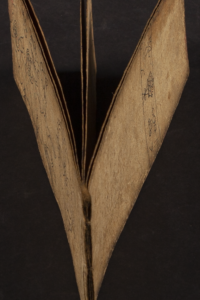
It wasn’t until the Austro-American botanist explorer Joseph Rock (1884–1962) began his expeditions into China’s mountainous southwest in the early twentieth century that the world began to have a clearer idea of what the enigmatic Naxi books contained. Rock, famous for being the National Geographic magazine’s “man in China” in the 1920s and 30s, was captivated by the ritual books he found in the possession of the Naxi dongba ritualists while plant hunting in China’s borderlands. Rock went on to devote the remaining years of his life to the translation of these books that contained what he believed to be a treasure house of knowledge, a corpus of literature that offered tantalizing glimpses at the indigenous religion of pre-Buddhist Tibet (for the Naxi had migrated south from Tibetan regions centuries before).
Rock, a formidable autodidact, appreciated an intellectual challenge: this was a script that, by the time he first encountered it in the 1920s, nobody had previously deciphered to any great degree of detail or accuracy. It was essentially unexplored territory, and this was where Rock liked to tread. Through his assiduous collecting and cataloguing, and not without controversy, he preserved thousands of these texts in collections now spread throughout the western world. Unfortunately, this legacy has not yet been fully developed by western scholars. This is primarily because to read these books requires the assistance of native Naxi ritual practitioners – the dongba who write them. Compounding the difficulty, the dongba do not always write down all the words that would be read during a performance: there is a looser relationship between the spoken and the written word than we might expect.
Looking at the opening page from Or. 25.255 (Figure 3), we can see a formulaic introduction to a Naxi manuscript. The five sections (each separated by a vertical line) could be read: “In the beginning, the stars shone brightly in the sky / the grass grew green across the earth / to the right, the sun gave off its warmth / to the left the moon shone over the hundred cliffs…/ up above, at the foot of the white cliffs of Lhasa…”. Almost all the syntax words, the prepositions and grammatical markers, are here supplied by the reader’s memory, which is jogged by the vivid depictions on the page.
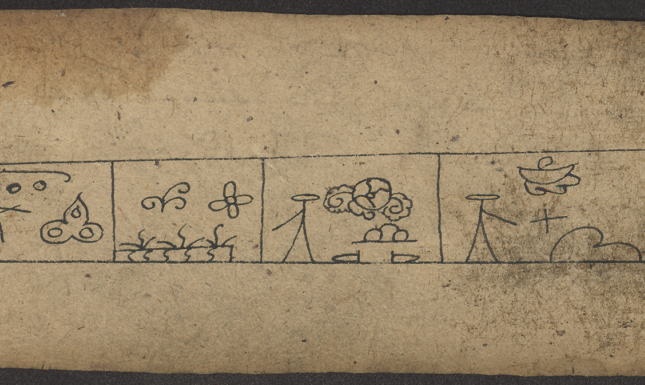

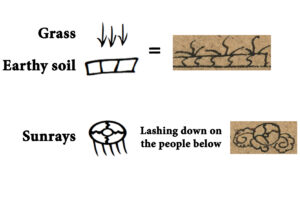

The words are combined in composite images that showcase the direct, vivid beauty of this script. In the second panel, for example, we can see the grass sprouting atop the earthy soil. Similarly, in the third panel, the sun’s rays are depicted in clear detail, lashing down upon the people below. This introductory passage sets up the auspicious nature of the ritual to be performed: the stars are shining, the grass is green, and the rite will, presumably, be successful!
Beyond the ritual
Besides their ritual content, the manuscripts often contain fascinating paratext: material outside of the main text of a ritual manuscript. This paratext can vary from casual doodles and finely detailed iconography on the back covers, to postscripts added by the dongba, or even hastily scribbled notes in blank spaces.
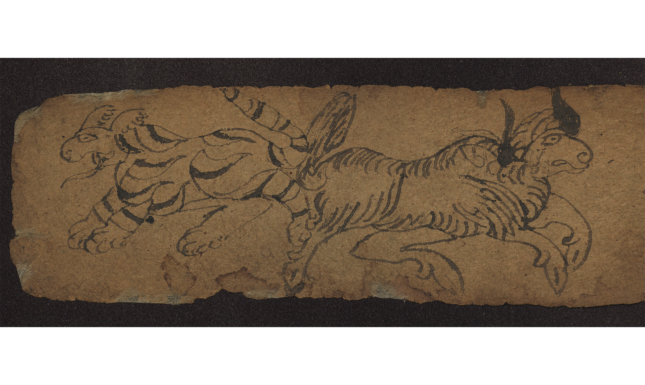

The dongba are not just ritual specialists, but calligraphers and artists too. They often decorate the empty pages of their books with drawings of animals, deities, and ritual practitioners. What makes these images unique is their nature as both writing and picture: a roaring tiger can be read as a word, la (tiger), as well as appreciated as a drawing. Figure 4 shows a tiger and a yak. Normally adversarial, these two animals have a special place in Naxi mythology. The tiger represents the ancestors, while the yak is an animal traditionally liberated during the most important religious ceremony of the year, the sacrifice to heaven. Both animals are steeds of the gods, and represent the free traversal of the Himalayan landscape: the Naxi warrior gods are said by Joseph Rock to be able “cross the mountain spurs like a tiger, the high alpine meadows like a romping yak”.
The script can also be used for more routine purposes. Or. 26.029 has two paratextual notes written by the dongba who copied the manuscript. The first can be found at the beginning on the inside front cover, where he writes, “My brother Nol, I hope you don’t mind that I have borrowed your book”, indicating that the author took this book from a colleague of his (a dongba with the sobriquet “Nol”), so that he could make a copy (see Figure 5 below).
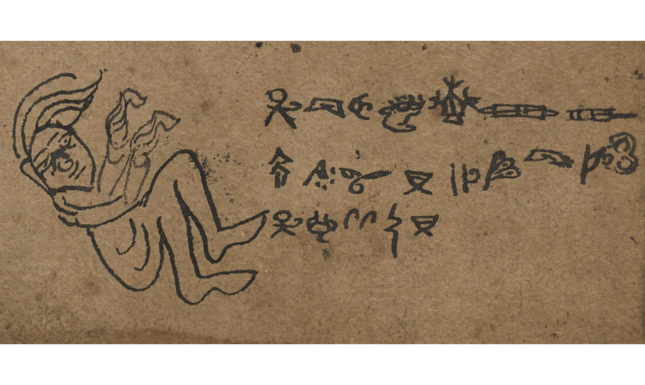

At the end of the text, the dongba states: “This book was written in the seventh month of the year of the ox, over a period of four sleepless nights. It is difficult to make a good one [i.e. a copy] late at night, the writing is not beautiful, and not up to standard.” Postscripts such as this tell us a lot about the context of how these books were written, how they changed hands, and how the tradition is passed down, not to mention revealing the typical self-effacing style of the dongba, here lamenting that writing the book in the early hours has resulted in a less than satisfactory calligraphic style.
More than that, however, such examples show the dongba script as a true writing system not reserved merely for esoteric ritual use, but one that can be used to communicate even relatively mundane information. This is a writing system that, given the proper conditions to develop, could have become mainstream in Naxi society. Inevitably, however, the cultural dominance of Chinese writing has left the dongba script developmentally stunted - the only people who can read texts such as these today are an increasingly small number of dongba ritualists, and a select handful of researchers. Nevertheless, we can still all appreciate the simple beauty of a writing where the gods battle and the tigers leap on the page before our very eyes.
________
Duncan James Poupard is an Assistant Professor in the Department of Translation at the Chinese University of Hong Kong, specialising in the translation of Naxi manuscripts.


